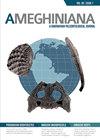阿根廷澳大拉盆地东南部Península Mitre的古新世晚期至始新世中期钙质超微化石组合
IF 1.5
4区 地球科学
Q3 PALEONTOLOGY
引用次数: 0
摘要
摘要。在富尔金大西洋海岸和安第斯褶皱和冲断带南部,古近纪部分由许多浊积岩矿床代表。在米特尔半岛的里奥·布埃诺和莱蒂西亚角之间,古新世-始新世以里奥·克拉罗组(莱蒂西亚角、拉巴尔卡角、蓬塔·诺盖拉和塞罗·鲁珀托组)和里奥·布埃诺组为代表;这共同构成了~1050-m-厚的继承。分析了从95个样本中回收的钙质超微化石组合,以确定它们的相对年龄。莱蒂西亚下士编队在超微化石中被清空。Barca组的上LB2成员含有菱形尖晶石和束状尖晶石,经常出现在古新世/始新世边界(NP9a/NP9b分区)。从Punta Noguera地层中恢复的超微化石表明了始新世早期(生物区NP9b-NP10),有鼓室束状体、菱形突和丰富的Toweius属。Cerro Ruperto地层提供了一个生产样本,其中有Reticofenestra属和Toweius属的样本,这表明了该地层的早始新世年龄(生物区NP12-NP13)。布埃诺河组产生了以大叶恰斯莫利图斯、大叶恰斯莫利图斯、托韦乌斯和网状化石为特征的钙质超微化石组合,这表明早始新世晚期至中始新世(生物区NP14-NP15)。虽然由于克拉罗河组的保存偏见,钙质超微化石记录是不连续的,但我们的数据为研究地层提供了更好的年龄限制,并将这些单位与南部盆地的其他地表和地下单位进行了校正。总结。在富吉纳大西洋沿岸和富吉纳安第斯山脉的褶皱和褶皱带中,古近纪部分由许多浊流系统代表。在米特尔半岛的布埃诺河和莱蒂西亚角之间,古新世-始新世由厚度约1050米的布埃诺河组和克拉罗河组(莱蒂西亚角、拉巴尔卡、蓬塔·诺格拉和塞罗·鲁珀托组)组成。本文分析了95个样品的钙质纳米化石组合,以确定它们的相对年龄。莱蒂西亚角地层在纳米化石中是无菌的。La Barca组的上部成员LB2含有菱形尖头和束状里查第的标本,常见于古新世/始新世边界(NP9a-NP9b亚区)。在Punta Noguera地层中恢复的纳米化石表明了早始新世(NP9b-NP10生物区),有鼓室束状体、菱形突和丰富的Toweius属。Cerro Ruperto地层提供了一个肥沃的样本,其中包括可分配给早始新世(NP12-NP13生物区)的Reticofenestra属和Toweius属的标本。Rio Bueno地层提供了以Chiasmolithus eograndis、Chiasmolithus expansus toweius spp.和Reticulofenestra spp.为特征的纳米化石组合,可归属于早始新世晚期-中始新世(生物区NP14-NP15)。虽然由于里约克拉罗群的沉积相,钙质纳米化石的记录是不连续的,但我们的数据可以更好地限制所研究地层的年龄,并将其与南部盆地的其他露头和底土单位联系起来。本文章由计算机程序翻译,如有差异,请以英文原文为准。
Late Paleocene to Middle Eocene Calcareous Nannofossil Assemblages from Península Mitre, Southeastern Austral Basin, Argentina
Abstract. On the Fueguian Atlantic coast and in the southern Andean fold and thrust belt, the Paleogene is partially represented by numerous turbiditic deposits. Between Río Bueno and Cabo Leticia in Península Mitre, the Paleocene–Eocene is represented by the Río Claro Group (Cabo Leticia, La Barca, Punta Noguera, and Cerro Ruperto formations) and the Río Bueno Formation; which together constitute a ∼1050-m-thick succession. Calcareous nannofossil assemblages recovered from 95 samples were analyzed to determine their relative ages. The Cabo Leticia Formation was barren in nannofossils. The upper LB2 Member of La Barca Formation contained Rhomboaster cuspis and Fasciculithus richardii, frequent in the Paleocene/Eocene boundary (subzones NP9a/NP9b). Nannofossils recovered from Punta Noguera Formation indicate an early Eocene age (biozones NP9b–NP10), with Fasciculithus tympaniformis, Rhomboaster cuspis, and abundant Toweius spp. The Cerro Ruperto Formation provided one productive sample, with specimens of Reticulofenestra spp. and Toweius spp., which indicates an early Eocene age for the formation (biozones NP12–NP13). The Río Bueno Formation yields calcareous nannofossil assemblages characterized by Chiasmolithus eograndis, Chiasmolithus expansus, Toweius spp., and Reticulofenestra spp., which indicate a late early Eocene to middle Eocene age (biozones NP14–NP15). Although the calcareous nannofossil record is discontinuous due to preservational biases in the Río Claro Group, our data allow a better age constraint for the investigated formations and to correlate these units with other surface and subsurface units in the Austral Basin. Resumen. En la costa atlántica fueguina y en la faja plegada y corrida de los Andes Fueguinos, el Paleógeno está representado parcialmente por numerosos sistemas turbidíticos. Entre el Río Bueno y el Cabo Leticia en Península Mitre, el Paleoceno–Eoceno está integrado por la Formación Río Bueno y el Grupo Río Claro (formaciones Cabo Leticia, La Barca, Punta Noguera y Cerro Ruperto) que alcanzan ∼1050 m de espesor. En este trabajo se analizan los ensambles de nanofósiles calcáreos de 95 muestras a fin de precisar sus edades relativas. La Formación Cabo Leticia resultó estéril en nanofósiles. El miembro superior de la Formación La Barca, LB2, contiene ejemplares de Rhomboaster cuspis y Fasciculithus richardii, frecuentes en el límite Paleoceno/Eoceno (subzonas NP9a–NP9b). Los nanofósiles recuperados en la Formación Punta Noguera indican una edad Eoceno temprano (biozonas NP9b–NP10), con Fasciculithus tympaniformis, Rhomboaster cuspis y abundantes Toweius spp. La Formación Cerro Ruperto proporcionó una muestra fértil, con ejemplares de Reticulofenestra spp. y Toweius spp., asignables al Eoceno temprano (biozonas NP12–NP13). La Formación Río Bueno, proveyó ensambles de nanofósiles caracterizados por Chiasmolithus eograndis, Chiasmolithus expansus Toweius spp. y Reticulofenestra spp., asignables al Eoceno temprano tardío - Eoceno medio (biozonas NP14–NP15). Aunque el registro de nanofósiles calcáreos es discontinuo debido a las facies sedimentarias del Grupo Río Claro, nuestros datos permiten una mejor restricción de la edad de las formaciones investigadas y correlacionarlas con otras unidades aflorantes y del subsuelo en la Cuenca Austral.
求助全文
通过发布文献求助,成功后即可免费获取论文全文。
去求助
来源期刊

Ameghiniana
地学-古生物学
CiteScore
2.50
自引率
10.00%
发文量
21
期刊介绍:
Ameghiniana is a bimonthly journal that publishes original contributions on all disciplines related to paleontology, with a special focus on the paleontology of Gondwana and the biotic history of the southern hemisphere. Published yearly since 1957, it has undoubtedly become the main palaeontological publication from Latin America. Ameghiniana has recently broadened its editorial board, reorganized its production process, and increased to a bimonthly frequency, which resulted in a significant decrease in the turn around time.
 求助内容:
求助内容: 应助结果提醒方式:
应助结果提醒方式:


